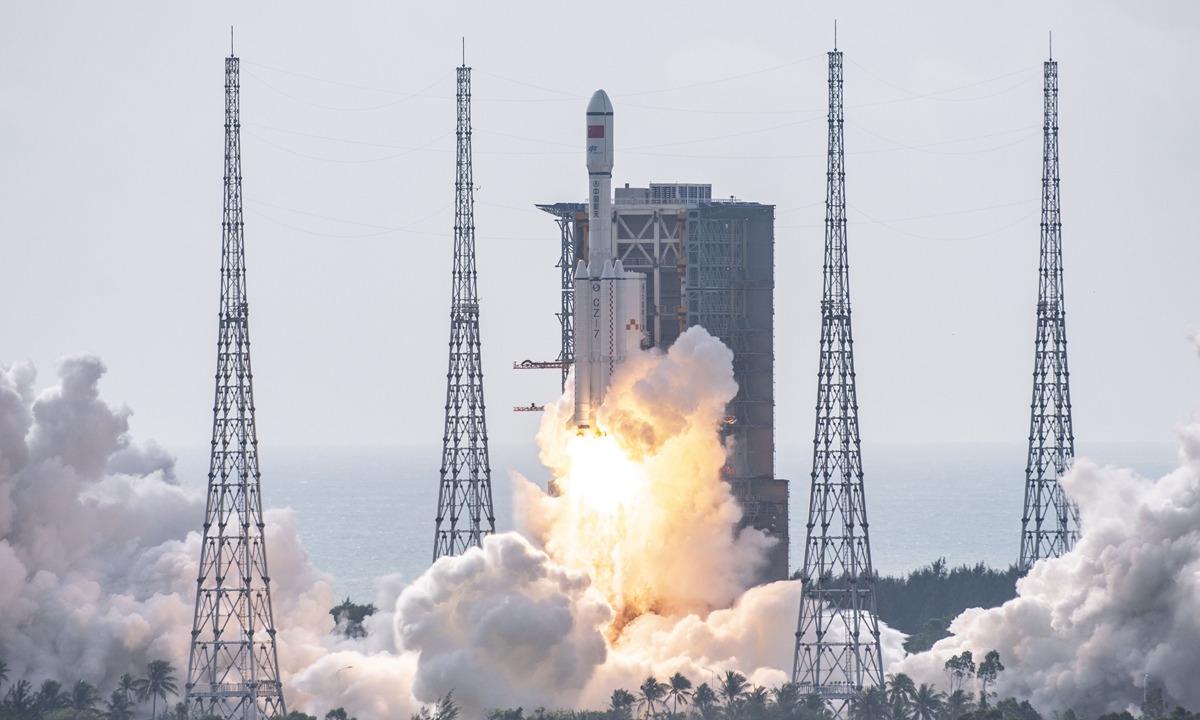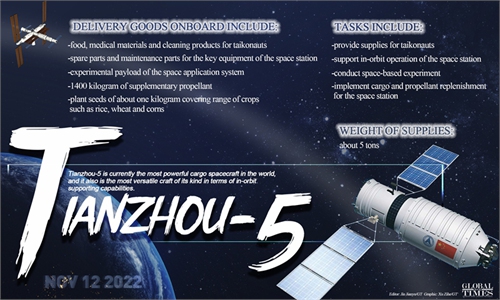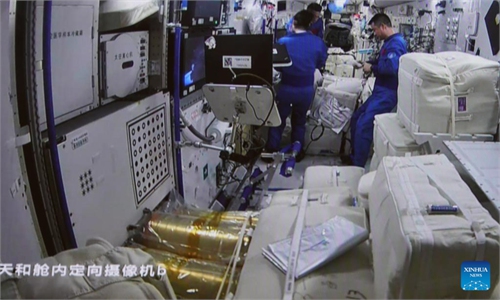Shenzhou-14 crew enters Tianzhou-5; cargo mission sets new world record for fastest rendezvous and docking operation

The Tianzhou-5 cargo spacecraft is launched via a Long March-7 carrier rocket from Wenchang Space Launch Site, South China's Hainan Province, on Saturday around 10 am. Photo: VCG
The Shenzhou-14 crew entered the Tianzhou-5 cargo spacecraft on Sunday at 3:03 pm, after they completed environment testing of the newly launched and docked spacecraft, the China Manned Space Agency (CMSA) said. The taikonauts will transfer the cargo according to schedule, the Global Times learned from the CMSA on Sunday afternoon.
China has just set the new world record of fastest rendezvous and docking operations between two spacecraft with its Tianzhou-5 cargo supply mission to the country's Tiangong Space Station on Saturday. It was a great achievement marking that China has mastered autonomous orbit determination capability with even higher precision and improved adaptability, and signaling that the country's space rendezvous and docking technology has increasingly matured, mission insiders said on Sunday.
The China Academy of Spacecraft Technology (CAST), the developer of the Tianzhou-5 cargo spacecraft, told the Global Times that the much-shortened ground-to-space transportation capability would enable shipments of live experimental projects to the space station, while it also has the potential of being applied in a space rescue situation.
It is a sign of an overall advance of the country's spacecraft's autonomous orbit determination capability with higher precision and optimized flight control measures. It would also lay the ground for more diverse rendezvous and docking modes in the future with a wider range of functions, it noted.
The Tianzhou-5 cargo spacecraft was launched via a Long March-7 carrier rocket from Wenchang Space Launch Site, South China's Hainan Province, on Saturday around 10 am and it reached China Space Station in just two hours at midday on Saturday, the CMSA said.
With the ultrafast rendezvous, the Tianzhou-5 cargo spacecraft has broken the record held by Russia's manned spacecraft Soyuz MS-17. The manned Russian craft took 3 hours and 3 minutes from launching to docking with the International Space Station on October 14, 2020.
The Tianzhou cargo spacecraft series bears witness to the rapid development of China's technology of space rendezvous and docking.
It took Tianzhou-1 about two days to dock with the Tiangong-2 space lab on April 22, 2017. Adopting an autonomous and fast rendezvous and docking technology, Tianzhou-2 docked with China's Tianhe space station core module on May 30, 2021, some eight hours after being launched.
Following that, China further reduced the time for the Tianzhou spacecraft delivery run during the space station's construction. It took about 6.5 hours for Tianzhou-3 and Tianzhou-4 to achieve the feat on September 20, 2021 and May 10, 2022 respectively.
Compared to previous 6.5-hour operations, Tianzhou-5 has made adjustments at two stages to achieve the ultrafast 2-hour rendezvous and docking feat. Tianzhou-5 has streamlined the long-distance guidance stage from several orbits to less than one and reduced the time for maneuvering orbital changes down to two, from what used to be many times. And thanks to that, time spent on this stage was shortened to about one hour from some four hours in the old strategy, according to CAST.
Besides, there are less mooring points at the autonomous control stage as the cargo module approaches the space station combination. Fewer stops helped streamline the process to about 40 minutes from more than two hours, the academy said.
It is an upgrade from being a "chartered space freight train" to a "space cargo high-speed bullet train," CAST said.
Saturday's Tianzhou-5 space launch marked multiple firsts in China's aerospace history.
Besides the record-setting rendezvous and docking, the Tianzhou-5 mission marked the first visit to the China Space Station after the assembly of the T-shape basic structure was completed on November 3.
The successful docking of the Tianzhou-5 with the 80-ton-level space station combination verified the adaptability of the cargo spacecraft with a heavyweight target, mission insiders said.
It was also the first cargo spacecraft to dock with the China Space Station with taikonauts on board. Tianzhou-5, according to CAST, has also been equipped with the capability of enabling manual operation if there are malfunctions in the docking process.
The Tianzhou-5 carries supplies weighing some 5 tons, which includes food, medical materials and cleaning products for the taikonauts, especially for the Shenzhou-15 taikonauts' six-month stay next.
Also onboard the craft are spare parts and maintenance parts for the key equipment of the space station, the experimental payload of the space application system, and 1,400 kilograms of supplementary propellant, according to a statement CAST provided to the Global Times.
CAST stressed that it is an understatement to call the Tianzhou spacecraft a "space deliveryman," since it now possesses more functions beyond cargo ferrying.
Three experimental payloads were onboard the Tianzhou-5. That includes the country's first-ever fuel cell for space application that was also developed by CAST, which will be used to conduct the country's first fuel cell in-orbit experiment to verify the performance of the fuel cell and to explore how the environment in space, including microgravity, would impact its performance. Such research and study will provide firm support for the development of China's manned moon probe missions in the future, according to CAST.
Pang Zhihao, a Beijing-based space expert, told the Global Times that China is making new attempts and boosting its technology advances in every new launch, showing the courage and confidence of China's manned space programs.



